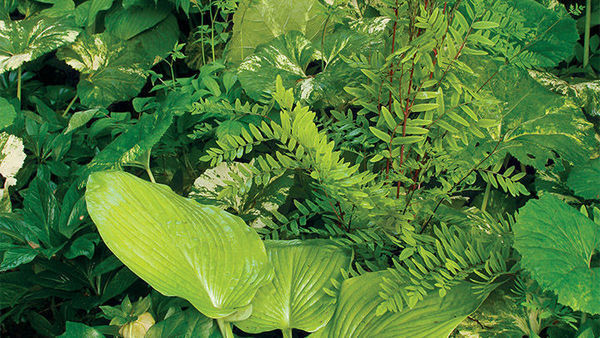
“Eco roof,” “live roof,” “planted roof,” “green roof”—enough roofs to drive you up one. Whatever you call it, the approach is the same: to plant directly onto a roof’s surface. While that seems simple, the design and execution take some planning.
A properly constructed green roof consists of several layers designed to protect your roof structure while retaining adequate soil and moisture for your plants. And it isn’t just for looks. A correctly installed green roof can reduce runoff and cool indoor temperatures. Cool, eco-friendly, and a new place to plant—it’s no wonder this idea is so popular.
But before you scamper up a ladder to turn your unattractive flat or slightly pitched roof into a vibrant growing surface, before the medium or even a single plant is put in, consult the professionals. The planning and engineering required is well worth the investment when it’s done right.
Know your restrictions
Look into your zoning, neighborhood restrictions, and insurance coverage related to installing a green roof before taking any other action. Because many neighborhood associations enforce uniformity of landscape and architecture, your association may not permit installation of a visible green roof; it’s best to ask before you make the investment. Also, keep your insurance company aware of any structural alterations you make to your home. Because green-roof coverage is a gray area for most insurance companies, it is smart to keep the lines of communication open.
Make sure your roof is up to the job
First, evaluate the slope of your roof. Flat roofs are easier and less expensive to work with than sloped roofs, and some sloped roofs require a baffle system to hold the soil in place; an extremely steep pitch is not recommended for planting.
Second, ask a structural engineer to determine whether the existing roof’s load-bearing capacity is adequate; plan for an additional 24 pounds of weight per square foot. And inspect the roof for signs of damage and wear; mend or replace any area in question before proceeding with construction.
Consider maintenance and access needs
Like in-ground gardens, rooftop landscapes require some maintenance. Plan how you will weed and water your plantings. Maintenance may not be the only reason you need to access the roof; a green roof may interfere with simple activities such as servicing the chimney, installing a satellite dish, or hanging Christmas lights.
Like the look of this green roof?
Create this growing tapestry—or one like it—by selecting plants that are low maintenance, love the sun, and have shallow and drought-tolerant root systems. Choose a palette with contrasting colors and textures. Include plants with low-growth habits that provide year-round seasonal interest. It’s also smart to use plants that spread or self-sow; they will fill in fast, saving you time and money.
|
|
ChivesName: Allium schoenoprasum (Zones 5–11) Why it works: Its short, bulbous root system tolerates dry, shallow soil. The lush green spikes add texture, and the pompon pink flowers add a sprinkle of color. |
‘Fuldaglut’ sedumName: Sedum spurium ‘Fuldaglut’ (Zones 4–9) Why it works: It tolerates dry, shallow soil. It has vigorous, mat-forming, bronze-red growth that is evergreen. |
|
|
|
‘Albus’ mother of thymeName: Thymus serpyllum ‘Albus’ (Zones 4–9) Why it works: Its shallow roots demand well-drained soil. It spreads and is easily divided to cover a large area. |
From foundation to foliage, every tier of a green roof is essential
A complete green roof consists of five layers. Installed correctly, these layers will protect your roof and mimic
conditions found in nature, making it possible to transform your bare space into green space.

1. Roof-deck waterproofing
The base is the most important element. Its functions are to prevent water from leaking through your roof and to protect it from root penetration. Your current roof surface will probably suffice, but consult your roofing contractor to confirm that it’s up to the job.
2. Drainage system
The pitch of your roof will determine what type of drainage system you need. Systems vary from simple fabrics to ones that channel water through V-shaped troughs. An effective drainage system will handle surface and subsurface water, transport excess water to gutters and downspouts, and provide aeration to roots.
3. Root-permeable filter layer
The functions of this layer are to hold the growing medium in place and to prevent small particles from washing out to the drainage layer and clogging up the system. This simple mat filter can usually be incorporated with the drainage layer.
4. Growing medium
The growing medium retains moisture, drains excess water, provides and absorbs nutrients, and anchors plants, while keeping the structural load as light as possible. You need no more than a 6-inch-thick layer of mostly inorganic medium; expanded clay and slate work well.
5. Plants
Limit your palette to low-growing, low-maintenance plants. Stay away from deep-rooted, tall plants that can dry out and become a fire hazard.
—Lucie Snodgrass is coauthor with her husband, Edmund, of Green Roof Plants: A Resource and Planting Guide. They own Emory Knoll Farms in Street, Maryland.




















Comments
Log in or create an account to post a comment.
Sign up Log in